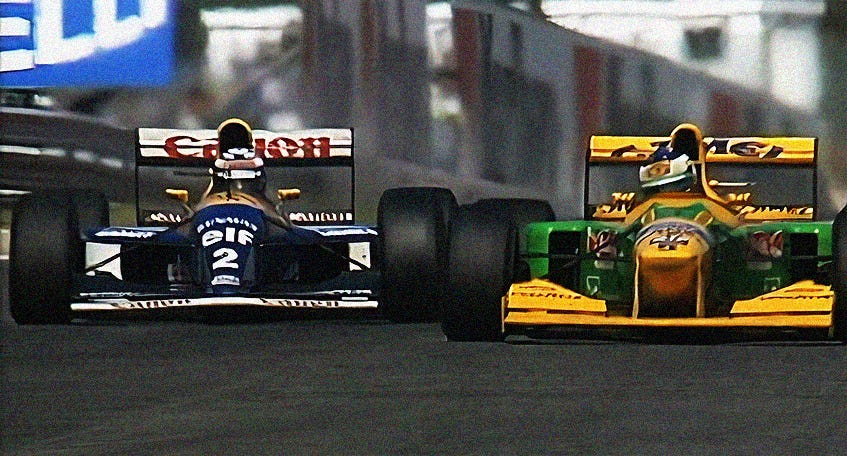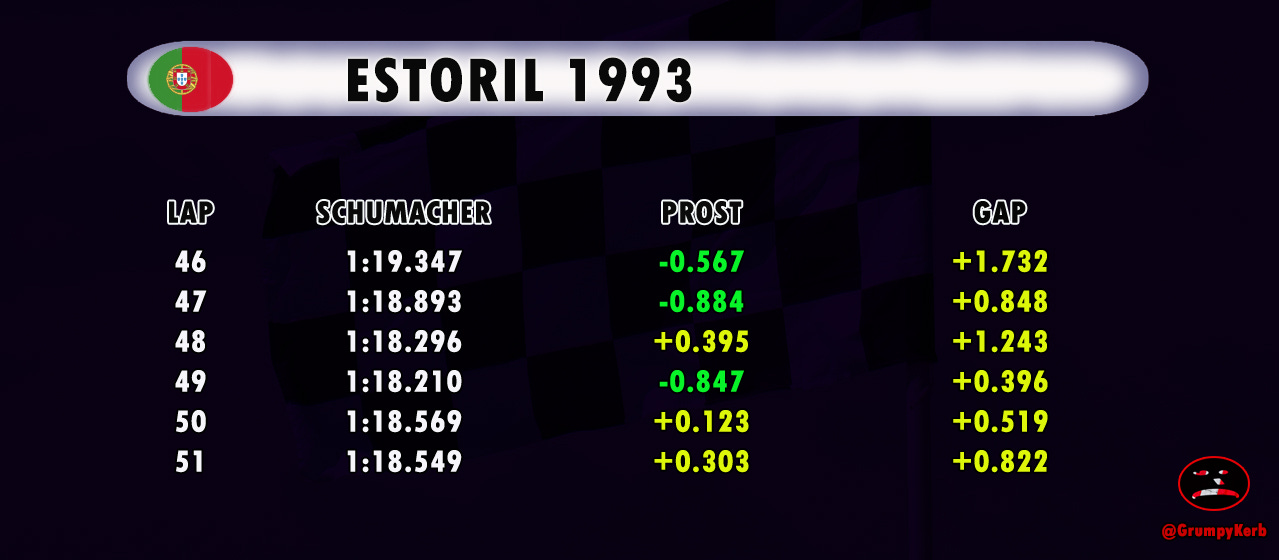German Frustrations on Portuguese Soil: Schumacher's Second Victory
The German could've won the 1993 Portuguese Grand Prix more easily, if it hadn't been for an obstinate backmarker.
Michael Schumacher's victory in the 1993 Portuguese Grand Prix, the second on his resume, is far from his most acclaimed wins. It ranks among the lesser-known, perhaps slightly underrated ones, overshadowed by the likes of Belgium 1995, or China 2006.
Still, it’s an impressive performance, considering that the Benetton driver had both his racing prowess and sanity tested. The latter was due to a particular challenge—one that, in hindsight, seems quite comical, but was undoubtedly blood boiling from within the cockpit.
A Blessing in Disguise
The German qualified 6th, having struggled with his car throughout Friday and Saturday. On Saturday night, he worked late with his mechanics to resolve the handling issues that had compromised his qualifying and caused him to spin several times. (Nowadays it’s illegal, of course, but not back then. The modern parc ferme was introduced ten years later.)
Schumacher had some luck on his side: Damon Hill stalled on the grid and was forced to start from the back, while Ayrton Senna's engine failed early in the race. With two competitors out of his way, Schumacher took care of the other two: Jean Alesi and Mika Hakkinen, by pitting a lap after them. He also leapfrogged his main rival for the win, Alain Prost, by utilizing an undercut.
The plan was to stop twice. The German ultimately abandoned it once he gained track position over Prost. At this point, the strategies of both drivers converged, but the Frenchman had 8 laps younger tires, as he had intended to execute a one-stopper from the get go.
Maneuvering Through Traffic
The Benetton driver took the lead on lap 30. To get the W, he needed to fend off the challenge from Prost in the superior Williams for the remaining 41 tours.
The race leader was sitting pretty at the start of his quest for victory. He not only maintained a safe distance of 2 to 3 seconds from the Frenchman but also built a cushion of nearly 7.5 seconds when the Williams driver struggled to navigate through traffic on lap 40.
Yet, the gap between the two was systematically shrinking. Then, Schumacher approached a group of backmarkers.
The first of the bunch, Martin Brundle, the German's former teammate, cost him more than 3 seconds relative to Prost. The second, his current teammate at the time, Riccardo Patrese, let him through on the main straight. Eric Comas, who was about to be lapped for the second time, also didn’t give the leader a headache, and smoothly let him through.
The Finnish Delinquent
In the middle of lap 46, there was only one backmarker for Schumacher to lap: his future teammate, Jyrki Jarvilehto, a Sauber driver commonly known as JJ Lehto, the true star of this post. The Finn didn't give way. He didn’t give an inch and held off the race leader for 6 laps, costing Schumacher precious time relative to Prost.
The German repeatedly appeared in Lehto’s mirrors, shaking his fist and even attempting to force his way through on the inside, only to be met with the Finn chopping across Senna style in front of his nose. What was aiding Lehto in his ferocious defense, was the narrow and winding layout of the Estoril circuit, which offered few opportunities for overtaking.
Additionally, there were no blue flags in 1993; they were introduced two years later. Nevertheless, backmarkers were required to allow the leaders to pass.
Schumacher, winless up to that point in the season, was presented with an opportunity that might not come again, so he had to exercise extra caution. He couldn’t afford to make a risky maneuver. However, he also couldn’t just sit behind the Sauber. This was only helping Prost, who was soon breathing down his neck.
From lap 49, the German not only had to find a way to pass Lehto, but he also needed to keep an eye on Prost. I can only imagine the insults Schumacher must have shouted at the stubborn backmarker and the homicidal fantasies that may have crossed his furious mind.
Angry, stressed, and frustrated, with the unyielding Sauber in front and the Williams hot on his heels, Schumacher somehow managed to maintain the lead, and his sanity.
The end of lap 51 brought a blissful relief to the frustrations of the Benetton driver. Lehto finally came to his senses and allowed both race leaders to pass.
The Root of All Evil
So why did the Sauber driver decide to be such a pain in the ass? Well, he didn't. Previously, in a battle for P7, he had been putting Derek Warwick under pressure, while simultaneously defending against the other Benetton, driven by Patrese.
In the heat of the action, he likely didn’t realize that the yellow-green car in his mirrors was no longer the one driven by the Italian. Consequently, he fought tooth and nail for his position. This is at least what BBC commentator Jonathan Palmer suspected, and it was also reported by Motor Sport magazine.
The most fascinating aspect of this comedy of errors is why Sauber did not immediately radio Lehto to let Schumacher through? It would have spared them a 10 second stop and go penalty, which ultimately cost the team the opportunity to finish P6 and score a point.
The Franco-German Skirmish
As for Schumacher, he withstood Prost's pressure for the remaining 20 laps and won.
Second place was sufficient for the Frenchman to secure his fourth title, but he aimed to seal it with a W, although not at any cost.
Prost was a highly calculated, cautious, and long-term oriented competitor. He did not resort to desperate attacks; that was not his style, nor was it a wise strategy against a driver who, on the racetrack, was as territorial as a Siberian tiger. Instead, he kept breathing down Schumacher’s neck and methodically tried to force him into a mistake, but to no avail.
The German remained unfazed until the very end.






